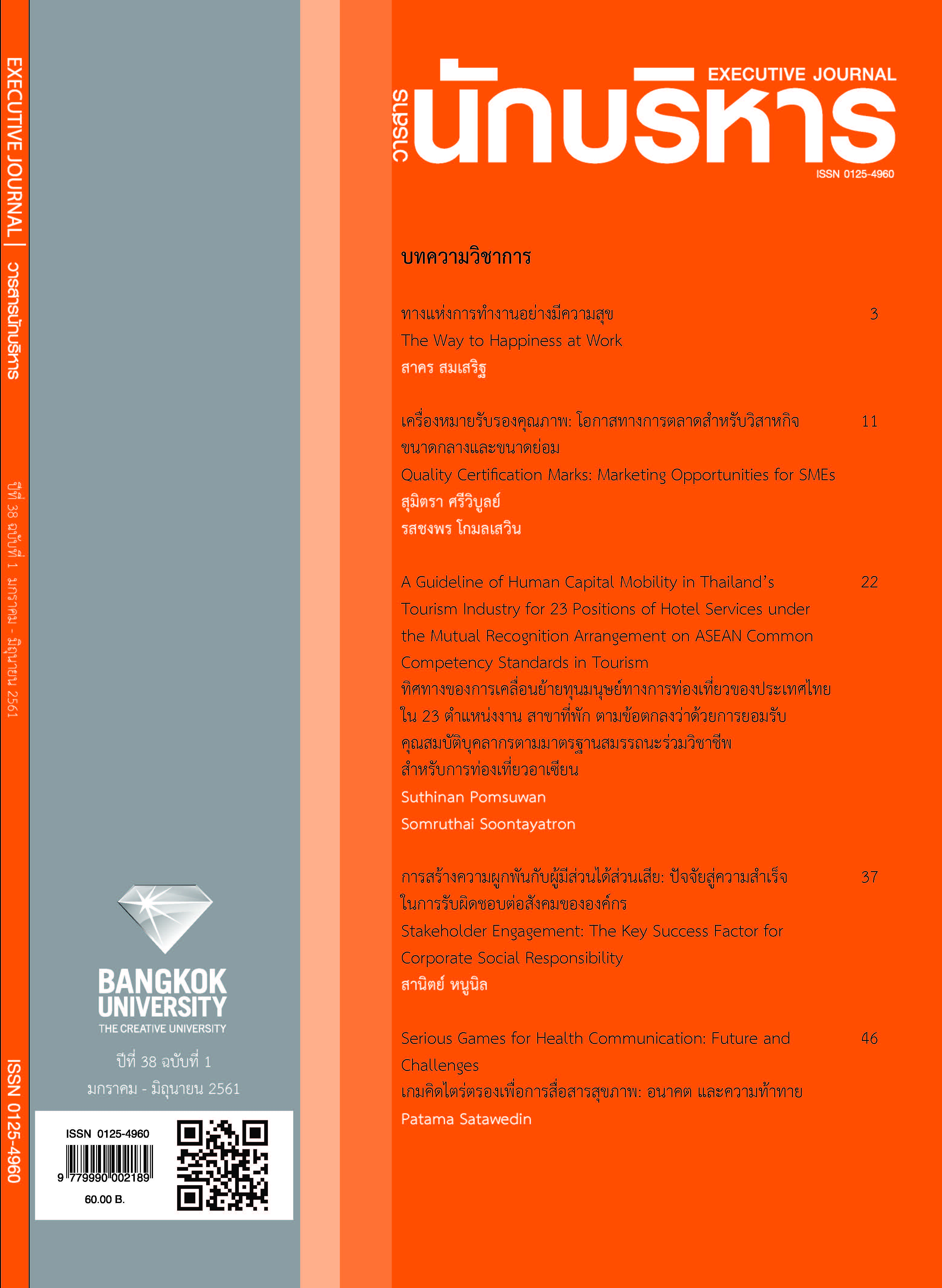Quality Certification Marks: Marketing Opportunities for SMEs
Main Article Content
Abstract
Marketing competition since 1990s has moved to product differentiation to generate higher returns, using particularly a distinctive attribute or a certification issued by a reliable organization. In addition, products exported to the overseas markets presently need to have some kinds of certification marks to assure their uniqueness, sales increase, and protection from pirated or counterfeit products.
This article aims primarily to provide information concerning existing types of certification marks as a marketing option for the SMEs to use the ones that suit their product type and would benefit their product the most. The proper use of certification marks will enhance consumer awareness and increase market opportunities and benefits. In this aspect, the sustainable and successful quality assurance stems basically from a strong-willed community to protect its cultural heritages and wisdom via the certification marks. The government’s supports are also needed in terms of providing relevant knowledge to the entrepreneurs, and exercising efforts to generate robust protection of the certified products both domestically and internationally.
Article Details
The manuscript submitted for publication must be the original version, submitted only to this particular journal with no prior acceptance for publication elsewhere in other academic journals. The manuscript must also not violate the copyright issue by means of plagiarism.
References
Agarwal, S., & Barone, M. J. (2005). Emerging issues for geographical indication branding strategies. Retrieved February 7, 2018, from https://lib.dr.iastate.edu/matric_researchpapers/5
Barjolle, D., Paus, M., & Perret, A. O. (2009). Impacts of geographical indications-Review of methods and empirical evidences. Paper presented at the 2009 International Association of Agricultural Economists Conference, August 16-22, 2009, Beijing, China. Retrieved February 7, 2018, from https://ideas.repec.org/p/ags/iaae09/51737.html
Bramley, C., Bienabe, E., & Kirsten, J. (2003). The economics of geographical indications: Towards a conceptual framework for geographical indication research in developing countries. Retrieved February 7, 2018, from https://www.wipo.int/edocs/pubdocs/en/wipo_pub_1012-chapter4.pdf
Chiarakul, T. (2557). Panhā læ nǣothāng kān prap tūa khō̜ng OTOP phư̄a phrō̜m rap kān
pœ̄t AEC [The problems and the adaptation of OTOP to AEC]. Executive Journal, 34(1), 177-191.
Cohen, E. (2012). Intellectual property protection: Options for traditional communities. Retrieved February 7, 2018, from https://iipi.org/2012/11/1749/
Department of Intellectual Property. (2018). Rāi chư̄ phū dai rap ʻanuyāt hai chai trā sanyalak sing bongchī thāng phūmisāt [List of entrepreneurs who got approval to use GI marks for their products]. Retrieved March 16, 2018, from https://www.ipthailand. go.th/th/gi-012.html
ʻI yū khưn thabīan khāo sang yot mư̄ang Phatthalung pen sinkhā čhī ʻai lǣo [EU registers “Pattalung Sung Yod Rice” as GI product]. (2016, October 13). Matichon Online. Retrieved March 16, 2018, from https://www.matichon.co.th/news/319986
Jaiborisudhi, W. (2016). Kānsưksā khrōngkān nưng tambon nưng phalittaphan (OTOP) phāitai wāt kam khwāmpen sinkhā. [A Study on One Tambon One Product (OTOP) project and the product discourse]. International Journal of East Asian Studies, 20(2). Retrieved February 7, 2018, from
https://www.tci-thaijo.org/index.php/easttu/article/view/82708/65715
Jay, T., & Taylor, M. (2013). A case of champagne: A study of geographical indications. Corporate Governance e-Journal, Special Issue. Retrieved February 7, 2018, from https://epublications.bond.edu.au/cgej/29
Komolsevin, R., Swasdisan, P., & Sriviboone, S. (2017). Mummō̜ng phūprakō̜pkān Thai
tō̜ māttrathān hālān [Perceptions of Thai entrepreneurs of Halal standards].
(Research report). Bangkok: The Thailand Research Fund.
Nak cho̜prun yao chư̄a SNS lư̄ak sư̄ sinkhā læ bō̜rikān [Young shoppers believe in SNS to purchase products and services]. (2017). Department of Intellectual Property, 23 (March 4-10). Retrieved February 7, 2018, from
https://www.ditp.go.th/contents_attach/164695/164695.pdf
Phawathaksa. (2017). GI 4.0 (EP. sām) kō̜ranī sưksā: Yīpun rēng čhotthabīan sinkhā kasēt nai tāng chāt [GI 4.0 (EP.3) Case study: Japan urging on registering agricultural products in international forum]. Retrieved March 16, 2018, from https://www.smartsme.co.th/content/64352
Ruzevicius, J. (2012). Products quality religious-ethnical requirements and certification. Economics and Management, 17(2), 761-767.
Sriviboone, S. (2011). Ok bǣp ʻō̜kbrǣn: Rabop māttrathān ʻattalak phư̄a kānsāng ʻattalak thī yangyư̄n [Design of brands: Systems of identity standards to create sustainable identity]. Bangkok: Display.
Traditional Cultural Expressions. (2018). World intellectual property. Retrieved March 16, 2018, from https://www.wipo.int/tk/en/folklore/
Wilson, J. A. J. (2012). The new wave of transformational Islamic marketing. Journal of
Islamic Marketing, 3(1), 5-11.


